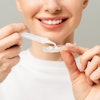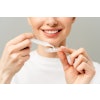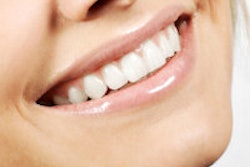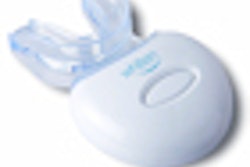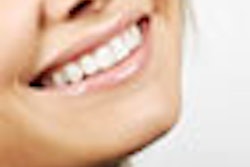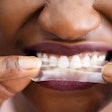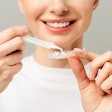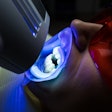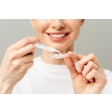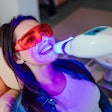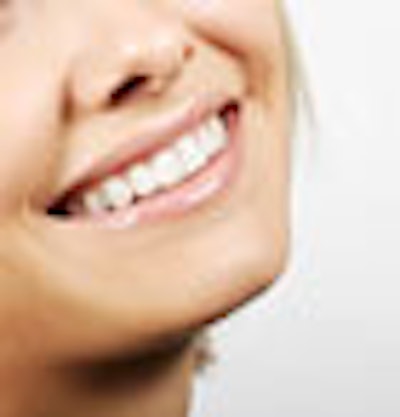
A study to be presented at the upcoming International Association of Dental Research (IADR) meeting in Barcelona, Spain, found that 35% hydrogen peroxide alone is effective in whitening teeth and that light activation does not improve the effect.
While the study is small, it raises an important question: Is light activation beneficial?
Researchers from the Egas Moniz Institute of Health Sciences in Portugal wanted to evaluate the efficacy and safety of light-activated, in-office dental bleaching and selected 10 patients to participate in a pilot randomized controlled clinical trial.
A split-mouth design was applied and two groups were studied: left or right upper and lower incisors and canines (6 teeth), with A3 as a minimum value measured on a Vitapan Classical scale (Vident).
The experimental group underwent bleaching with a 35% hydrogen peroxide gel using the Beyond Power whitening system with halogen light activation (Beyond Whitening Accelerator). The control group underwent bleaching with the 35% hydrogen peroxide without light activation.
Study findings
The researchers used the Vitapan Classical scale to measure the color change at three different periods: before treatment, immediately after treatment, and two weeks after treatment.
Among the study findings:
- No significant difference in efficacy was found between the two groups immediately after treatment and two weeks later.
- No significant difference was observed in sensitivity between the two groups during treatment and until 24 hours after treatment.
- Soft-tissue lesions occurred in both groups but without a significant difference .
"These results were exactly what we expected and confirm that the effect of whitening is due strictly to the gel used," said lead author Joana Vasconcelos e Cruz in an interview with DrBicuspid.com.
There is a lack of evidence in literature to support the fact that light activation can enhance in-office bleaching effects, and company claims are not always backed by clinical evidence, she added.
"According to a survey conducted by Clinical Research Associates [2000], the use of light is based mostly on visual effect and commercial proposes," Cruz said. "Although there are several reports that confirm in-office bleaching with light has no benefits, more and more patients continue to prefer this method."
Small sample size
Some experts, however, questioned the validity of these results.
Joe Ontiveros, D.D.S., clinical aesthetic dentistry director at the University of Texas who has conducted similar research, did not consider this pilot study as strong evidence for or against bleaching lights.
“You pay a lot of money for a light, and it should give more than a minimal benefit.”
— Gerard Kugel, D.M.D., Ph.D.
His study found that treatment with supplementary light showed significantly greater bleaching-dependent changes in color compared to treatment without light when assessed using instrumental methods and the visual method with Vita Bleachedguide 3D-Master (Journal of Dentistry, November 2009, Vol. 37:11, pp. 840-847). However, no significant difference in color change with respect to light exposure was detected for the Vitapan Classical shade guide.
"With only 10 patients, the analysis of the data may not have enough power to detect a significant effect," said Dr. Ontiveros of the IADR study.
Also, the only method reported for measuring color by the authors was the subjective use of the Vita Classical shade guide, and this guide is known to be flawed for scientific accuracy of color measurement, he added.
"Incorporating an objective instrumental method for color measurement, such as a spectrophotometer, and an increasing number of patients would have improved this investigation," Dr. Ontiveros said.
Beyond Dental and Health also pointed to the study's limited sample size.
"This small study was just 10 patients, all near A3 to start, and all in their 20s and 30s," said Joshua Granson, vice president and international marketing director for Beyond. "The average improvement in the halogen light-accelerated group was 6.9 shades -- less than one shade whiter than the control group. In other studies using our products, where average shades began far worse than A3 and patients had more room to improve before reaching B1, the results proved significantly better with the light than without."
Because the majority of American and European patients have strong, healthy enamel with mostly extrinsic food-related stains, bleaching to B1 or above from the middle of the Vita shade guide is relatively easy when using Beyond's second-generation 35% formula, he added. "In these cases, a Beyond Accelerator ensures consistency in the results, in a single 30-minute treatment, without discomfort or ultraviolet exposure."
Minimal benefits
Other experts, however, agreed with the researchers' findings.
Gerard Kugel, D.M.D., Ph.D., associate dean for research and professor of prosthodontics and operative dentistry at Tufts University School of Dental Medicine who has done similar research also found that light activation during whitening has minimal or no benefit (Journal of Esthetic and Restorative Dentistry, October 2009, Vol. 21:5, pp. 336-347).
"If we did not give the patients a take-home product, we saw a lot of rebound with light-activated systems," Dr. Kugel said.
Some products work better than others, he added. "For example, we found that some lights might have a small benefit, but they are still minimal," he said. "You pay a lot of money for a light, and it should give more than a minimal benefit."
Dr. Kugel does not use the light in his own practice but acknowledges that some dentists do believe that it works. Also, a lot of patients tend to ask for light-activated whitening, he acknowledged.
"It's a well-marketed product," he said.
Dr. Kugel himself is skeptical of the science touting the efficacy of light-activated bleaching and feels a lot of it is company-sponsored.
Still, he acknowledged, "In defense of the dental community, there are a number of papers out there that do support the notion that it [light] works."
Copyright © 2010 DrBicuspid.com

